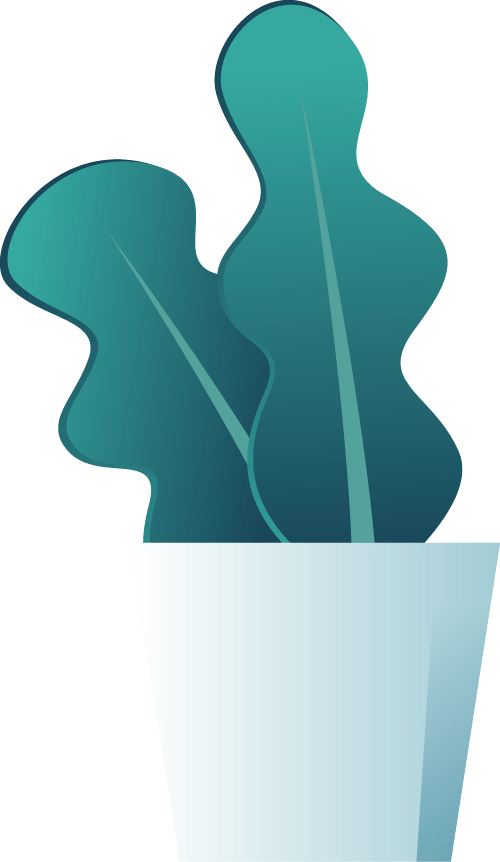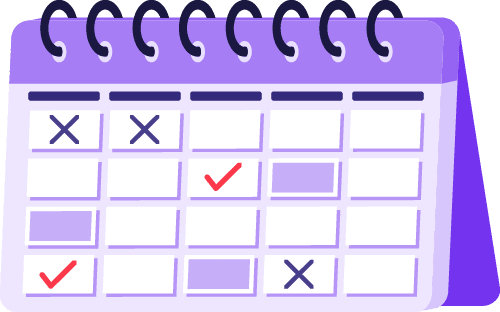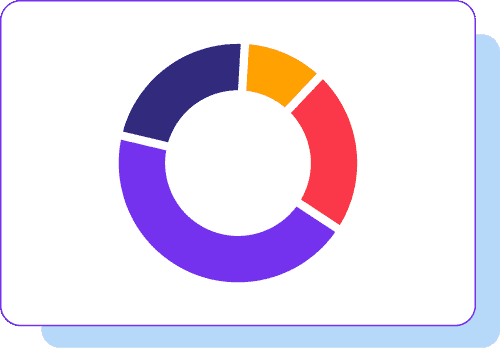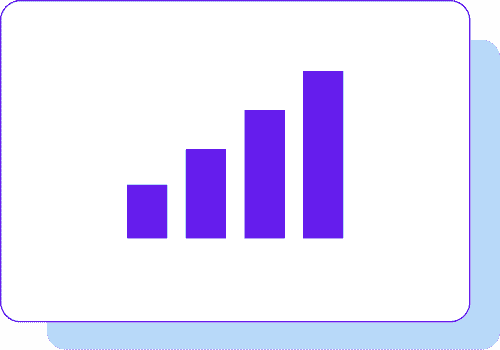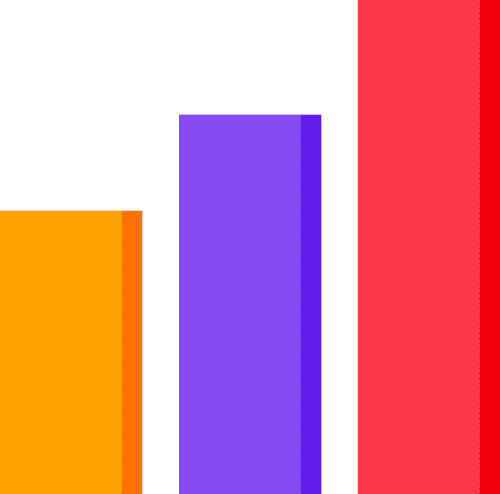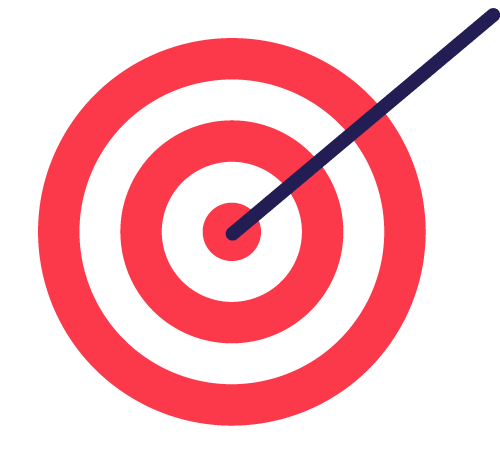Welcome to my Digital Marketing Glossary – your essential reference for deciphering the intricate world of digital marketing terminology. Whether you’re a seasoned marketer or just starting, this glossary simplifies concepts related to SEO, PPC, social media, email marketing, and more.
With this reference at your fingertips, you’ll confidently navigate the digital marketing landscape. Whether you’re a novice or pro, this glossary empowers your journey. Let’s embark on a journey to decode the language of digital marketing, one term at a time. Welcome to clarity!
What Is the Digital Marketing Glossary and Cheat Sheet?
It’s your one-stop-shop for understanding all those techy terms you’ve heard but might not fully understand. Whether you’re a seasoned digital marketing pro or a newcomer to the field, this glossary has your back. It’s like having your very own personal translator for all things digital marketing.
Now, you might be wondering where this glossary came from. Well, the concept of glossaries and cheat sheets has been around for ages, making complicated stuff a whole lot simpler. As for my glossary, it’s not just a random list of terms. Nope, it was born out of real-world necessity at my own digital agency, Oxspring Group. I created this glossary to make our own lives easier, help new team members get up to speed, and ensure everyone was speaking the same language in the world of digital marketing.
Here’s the kicker: in the digital marketing world, knowing your stuff is key. You can’t afford to be lost in translation when you’re making big decisions or landing clients. My glossary is a game-changer, especially when you pair it up with the Digital Mastery Series. This series is all about turning you into a digital marketing whiz, and the glossary is your trusty sidekick. Together, they give you the knowledge and lingo you need to thrive in this fast-paced world.

How to Use the Lexicon: A Step-by-Step Guide
Navigating my Digital Marketing Glossary and Cheat Sheet is a breeze, and it’s all thanks to your web browser’s trusty “Find” function. Here’s a casual, step-by-step guide to help you make the most of this resource, just like I do:
1. Let’s Get Started:
- First things first, open the “Digital Marketing Glossary and Cheat Sheet” in your web browser.
2. Summon the “Find” Function:
- To call upon this nifty feature, you’ll need to press “Ctrl” and “F” at the same time if you’re on Windows. If you’re a Mac user, try “Command” + “F.” This magic combo will conjure up a search bar or dialog box on your screen.
3. Enter Your Search Term:
- In the search bar, type the word or term you’re curious about. For example, if you’re wondering what on earth “SEO” means, go ahead and type “SEO” into the search bar.
4. Unleash the Search:
- Once you’ve typed your search term, hit “Enter” or give that “Find” button (usually hanging out next to the search bar) a little click. This will set your search in motion.
5. Explore the Results:
- Your web browser will work its magic and highlight or display instances of your search term on the page. You can move between different appearances of the term by using the “Next” and “Previous” buttons in the search bar.
6. Dive into the Lexicon Entry:
- Once you’ve found the term you were hunting for, dive in! Read up on the definition and any extra tidbits that come with it. If examples are provided, definitely take a look to get the full picture.
7. Keep on Discovering (If You Want!):
- If your curiosity isn’t satisfied or you’ve got more terms to explore, no worries! Just do it all over again. Press “Ctrl” + “F,” type in your next search term, and start the hunt all over again.
Using the “Find” function is like having your own personal search assistant. It’s an efficient way to quickly get to the bottom of those digital marketing terms you’re curious about. So whether you’re on a quest for a specific term or just on an exploration of digital marketing language, this feature’s got your back. Happy hunting!
Digital Marketing Glossary
| Term | Definition |
|---|---|
| A/B Testing | A method of comparing two versions of a webpage, email, or ad to determine which one performs better. It helps in optimizing and improving conversion rates. |
| Ad Click-Through Rate (CTR) | The percentage of users who click on an advertisement after seeing it. It’s a measure of an ad’s effectiveness in encouraging clicks. |
| Ad Impressions | The number of times an ad is fetched and displayed on a webpage, app, or other digital platform, regardless of whether it’s clicked. |
| Affiliate Marketing | A performance-based marketing strategy where businesses reward partners (affiliates) for driving customers or traffic to their website. Affiliates earn a commission for successful referrals. |
| Analytics | The collection and analysis of data to gain insights into the performance of digital marketing campaigns and website usage. |
| B2B Marketing | Business-to-Business Marketing – Marketing strategies and tactics aimed at selling products or services to other businesses rather than consumers. |
| B2C Marketing | Business-to-Consumer Marketing – Marketing strategies and tactics designed to target and sell products or services directly to individual consumers. |
| Blogging | The practice of regularly creating and publishing articles or blog posts on a website. Blogging is used to provide valuable content, improve SEO, and engage an audience. |
| Call to Action (CTA) | A prompt that encourages a website visitor or viewer of marketing content to take a specific action, such as signing up, making a purchase, or contacting the business. |
| Churn Rate | The rate at which customers stop using a product or service over a specific period, often measured as a percentage. High churn rates can indicate customer dissatisfaction. |
| Click Fraud | Illegitimate clicks on online advertisements with the intent of inflating advertising costs or depleting a competitor’s budget. It is a fraudulent activity. |
| Content Marketing | A marketing strategy focused on creating and distributing valuable and relevant content to attract and engage a target audience. |
| Conversion Rate | The percentage of website visitors who take a desired action, such as making a purchase, filling out a form, or signing up for a newsletter. It’s a critical metric for evaluating marketing success. |
| CRM (Customer Relationship Management) | A strategy and software system used to manage and analyze interactions with customers throughout their lifecycle, with the aim of improving customer relationships and retention. |
| CRO (Conversion Rate Optimization) | The process of systematically improving a website, landing page, or marketing campaign to increase the percentage of visitors who take a desired action or convert into customers. |
| Customer Persona | A detailed and semi-fictional representation of a business’s ideal customer, based on market research and data, to guide marketing strategies and messaging. |
| Digital Marketing | The use of digital channels and technologies, such as websites, social media, email, and online advertising, to promote products, services, or brands to a target audience. |
| E-commerce | Electronic Commerce – The buying and selling of products and services over the internet, typically through online stores or platforms. |
| Email Marketing | A marketing strategy that uses email to communicate with and engage customers, promote products or services, and build brand loyalty. |
| Funnel | A visual representation of the stages in a customer’s journey, from initial awareness through to purchase or conversion, often used in marketing to track and optimize the process. |
| Geo-Targeting | The practice of delivering specific content or ads to users based on their geographic location or other relevant factors. It’s often used for localized marketing campaigns. |
| Inbound Marketing | A strategy that focuses on creating and distributing valuable, customer-centric content to attract and engage prospects and leads naturally. |
| Influencer Marketing | A marketing approach that leverages the influence of individuals or entities with a dedicated and engaged following to promote products or services. |
| KPI (Key Performance Indicator) | Specific metrics and data points used to assess and measure the success or performance of a marketing campaign, strategy, or business objective. |
| Landing Page | A standalone web page designed for a specific marketing campaign, often with a clear call to action, intended to capture leads or prompt a particular action. |
| Lead Generation | The process of attracting and capturing potential customers (leads) who have shown interest in a product or service, typically through forms, landing pages, or other means. |
| Mobile Marketing | Marketing strategies and tactics tailored for mobile devices, including mobile-optimized websites, apps, and SMS marketing. |
| Organic Traffic | Website visitors who arrive at a site through unpaid, non-advertising means, primarily from search engine results. |
| Pay-Per-Click (PPC) | An online advertising model where advertisers pay a fee each time their ad is clicked. It’s commonly used in search engine and display advertising. |
| Remarketing (Retargeting) | A marketing strategy that displays ads to users who have previously visited a website but didn’t complete a desired action, such as making a purchase. It aims to re-engage potential customers. |
| Return on Investment (ROI) | A measure of the profitability of a marketing campaign or investment, calculated by comparing the gains (or revenue) against the costs (or expenditure). |
| Search Engine Marketing (SEM) | The practice of using paid advertising to appear in search engine results pages (SERPs) to increase visibility and attract potential customers. |
| Search Engine Optimization (SEO) | The process of optimizing a website’s structure and content to improve its visibility and ranking in search engine results, leading to more organic (unpaid) traffic. |
| SERP (Search Engine Results Page) | The page displayed by a search engine in response to a user’s query, featuring a list of web pages and other content relevant to the search terms. |
| Social Media Marketing | The use of social media platforms to promote products or services, engage with the target audience, and build brand awareness and loyalty. |
| Target Audience | A specific group of people or businesses that digital marketing efforts are aimed at, based on factors such as demographics, interests, and behavior. |
| Viral Marketing | A marketing technique that relies on creating and sharing content that spreads rapidly and widely across online communities and social networks, often driven by users’ sharing and participation. |
Social Media Glossary for Digital Marketing

| Term | Definition |
|---|---|
| Algorithm | A set of rules and calculations used by social media platforms to determine the content displayed in a user’s feed or search results, often based on relevance, engagement, and user behavior. |
| Analytics | The collection and analysis of data related to social media activity, used to track performance, engagement, and the effectiveness of social media marketing campaigns. |
| Avatar | A visual representation or user image used to identify an individual on a social media platform, often in the form of a profile picture. |
| Bio | A brief description in a user’s profile on social media platforms, providing information about the user, interests, and contact details. |
| Chatbot | A computer program or AI-powered tool that can engage in conversations with users on social media, providing information, assistance, and responses to queries. |
| Clickbait | Content that uses sensationalized or misleading headlines or imagery to entice users to click on links or engage with posts, often leading to disappointing or irrelevant content. |
| DM (Direct Message) | A private message sent between users on social media platforms, allowing one-on-one or group conversations separate from public posts. |
| Engagement | The level of interaction and activity surrounding a social media post, including likes, comments, shares, and clicks. |
| Follower | An individual who subscribes to and receives updates from another user’s or organization’s social media account. |
| Geotagging | The practice of adding location data to social media posts, allowing users to identify where content was created or shared. |
| Handle | A username or account name used to identify a user or organization on social media platforms, typically preceded by an “@” symbol. |
| Hashtag | A word or phrase preceded by the “#” symbol used on social media platforms to categorize and group content around specific topics or trends. |
| Influencer | An individual or entity with a significant following on social media platforms who can influence opinions, behavior, or purchasing decisions of their audience. |
| Like | A form of engagement on social media, often represented by a heart icon, used to show approval or appreciation for a post. |
| Mention | The act of tagging or referencing another user or account on social media by including their username in a post, often used to draw their attention to the content. |
| News Feed | The central area of a social media platform where users see a stream of content from accounts they follow or engage with, often customized based on algorithms and preferences. |
| Organic Reach | The number of users who see a social media post without the use of paid advertising or promotion. |
| Paid Advertising | Promoting social media content or advertisements to reach a larger and more targeted audience by paying for increased visibility and reach. |
| Profile | A user’s personal or business page on a social media platform, containing information such as name, bio, profile picture, and content. |
| Share | The act of reposting or forwarding someone else’s social media content to one’s own network or followers, spreading the content to a wider audience. |
| Social Listening | The practice of monitoring social media platforms to track and analyze online conversations and mentions of a brand, topic, or keyword. |
| Tag | A label or keyword used to categorize and identify content, users, or topics in a social media post. |
| Trending | Topics, hashtags, or content that are currently popular and widely discussed on social media platforms. |
| Troll | A user who intentionally engages in disruptive, inflammatory, or offensive behavior on social media platforms, often with the goal of provoking others. |
| Unfollow | The action of stopping or discontinuing the follow relationship with another user or account on social media. |
| User-generated Content (UGC) | Content created and shared by users, customers, or fans, often featuring products, services, or experiences related to a brand or organization. |
| Viral | Content or posts that quickly and widely circulate on social media, often due to widespread sharing and engagement. |
| Social Media Calendar | A schedule or plan that outlines the timing and content of social media posts, helping organizations maintain a consistent and strategic online presence. |
| Emoji | Small digital icons or symbols used to convey emotions, reactions, or visual representations in social media posts and messages. |
| Livestream | Real-time, live video broadcasts on social media platforms, allowing users to engage with content as it happens. |
| Social Media Manager | A professional responsible for planning, creating, scheduling, and managing content on social media platforms for individuals or organizations. |
| Story | Short, ephemeral content that disappears after a set period, typically used in formats like Stories on Instagram, Snapchat, and Facebook. |
| Verification Badge | A special icon or badge displayed on a user’s social media profile to verify their authenticity and legitimacy, often used by notable individuals and organizations. |
| Community Manager | A role responsible for building and maintaining an online community around a brand, product, or organization on social media, often involving engagement and customer support. |
| Social Media Campaign | A coordinated and organized effort to achieve specific goals or objectives on social media, often with a clear strategy, messaging, and timeframe. |
| Social Media Policy | A set of guidelines, rules, and standards established by individuals, organizations, or platforms to govern behavior and content on social media. |
| Social Share Buttons | Website or content elements that allow users to easily share the content on their social media accounts with a single click. |
| Dark Mode | A display option on social media platforms and apps that changes the color scheme to use dark backgrounds, often considered easier on the eyes in low-light conditions. |
Content Creation Gloassary for Digital Marketing
| Term | Definition |
|---|---|
| Audience | The specific group or target demographic that content is created for, often defined by factors such as age, interests, and location. |
| Blog | A frequently updated web page or website that features written content, often in a journal or article format, providing information, opinions, or news. |
| Content Calendar | A schedule or plan that outlines the timing and topics of content to be created and published, helping creators maintain a consistent and organized publishing strategy. |
| Copywriting | The art and science of writing persuasive and compelling copy, often used in advertising, marketing, and sales materials. |
| CTA (Call to Action) | A prompt or instruction within content that encourages the audience to take a specific action, such as signing up, making a purchase, or contacting the creator. |
| Distribution | The process of sharing and promoting content across various platforms and channels to reach a wider audience, including social media, email, and other distribution methods. |
| Evergreen Content | Content that remains relevant and valuable to the audience over an extended period, not tied to specific events or time-sensitive information. |
| Headline | A brief and attention-grabbing title for content that captures the essence of the topic and entices readers to continue. |
| Infographic | A visual representation of information or data using graphics, charts, and text to make complex concepts more easily understandable. |
| Keyword | A specific word or phrase that is strategically used in content to optimize search engine visibility, often related to the topic or subject of the content. |
| Landing Page | A web page specifically designed to capture leads, prompt an action, or provide more detailed information related to a specific campaign or offer. |
| Lead Magnet | An incentive or valuable content offered to the audience in exchange for their contact information, such as an eBook, webinar, or whitepaper. |
| Multimedia | Content that includes various types of media, such as images, videos, and audio, to engage the audience and deliver information in different formats. |
| Niche | A specialized and narrowly defined area or topic of interest, often used to identify the specific focus of content creation. |
| SEO (Search Engine Optimization) | The practice of optimizing content and website structure to improve visibility and ranking in search engine results, increasing organic traffic. |
| Social Proof | Evidence or indicators of credibility and trustworthiness, such as user reviews, testimonials, and social media shares, used to persuade the audience. |
| Target Keyword | A specific keyword or phrase chosen for content optimization, aiming to improve search engine rankings and attract relevant organic traffic. |
| User-Generated Content (UGC) | Content created and shared by users or customers, often featuring products, services, or experiences related to a brand or organization. |
| Visual Content | Content that relies heavily on images, graphics, videos, or other visual elements to convey information or engage the audience. |
| Whitepaper | A comprehensive and authoritative report or guide that provides in-depth information, analysis, and insights on a specific topic, often used for educational purposes. |
| Backlink | A hyperlink from an external website or online source that directs users to a specific webpage or content, used to improve search engine rankings and credibility. |
| Anchor Text | The clickable text within a hyperlink that provides context and describes the linked content, helping search engines understand the content’s relevance. |
| Link Building | The process of actively acquiring and creating backlinks to a website or specific content, aimed at improving search engine rankings and increasing referral traffic. |
| Link Juice | The authority or value passed from one webpage to another through a backlink, contributing to the linked page’s search engine ranking and visibility. |
| NoFollow Link | A type of hyperlink attribute that instructs search engines not to pass authority or ranking value from the linking page to the linked page, often used for user-generated or sponsored content. |
| Referral Traffic | Website visitors who arrive at a site through external sources or referrals, such as backlinks from other websites or social media links. |
| Broken Link | A hyperlink that no longer works or leads to a dead or non-existent page, often negatively affecting the user experience and SEO efforts. |
| Link Roundup | A blog post or article that compiles a list of valuable and relevant links or resources from around the web, often focused on a specific topic or theme. |
| Anchor Text Diversity | The practice of using a variety of anchor text phrases in backlinks to avoid over-optimization and improve the naturalness of link profiles. |
| Outreach | The process of reaching out to other webmasters, bloggers, or site owners to request backlinks or collaborations for content promotion and link building. |
| Guest Posting | A content creation and link-building strategy where an author contributes articles or content to other websites, typically in exchange for a backlink to their own site. |
| Content Audit | An evaluation and analysis of existing content to assess its performance, relevance, and quality, often leading to updates or optimization. |
Hypertext Transfer Protocol (HTTP) Glossary
| Term | Definition |
|---|---|
| HTTP | Hypertext Transfer Protocol – A protocol used for transferring data and documents on the World Wide Web, defining how messages are formatted and transmitted. |
| Request | An HTTP message sent from a client (typically a web browser) to a web server, specifying the action to be performed, such as retrieving a web page. |
| Response | An HTTP message returned from a web server to a client in reply to a request, containing the requested data or an indication of an error. |
| URL (Uniform Resource Locator) | A web address that specifies the location of a resource on the internet, including the protocol (e.g., HTTP), domain name, and path. |
| Domain Name | A human-readable label for a website, translated into an IP address by the Domain Name System (DNS), allowing users to access websites using names instead of numeric IP addresses. |
| Port | A number used to identify specific processes or services on a computer within a network, often used in URLs to specify the destination of an HTTP request. |
| Query String | A part of a URL that includes parameters and data to be sent with an HTTP request, often used in dynamic web applications to pass information to the server. |
| Header | A part of an HTTP message that contains metadata and information about the request or response, including data such as content type, date, and user agent. |
| Method | An HTTP verb that defines the action to be performed on a resource, including GET (retrieve data), POST (submit data), PUT (update data), DELETE (remove data), and others. |
| Status Code | A three-digit number included in an HTTP response that indicates the outcome of the request, with specific codes denoting success, redirection, client errors, and server errors. |
| Cookie | A small piece of data stored on a user’s device by a web browser, often used to track and store information about the user’s browsing behavior and preferences. |
| Cache | A mechanism that stores and saves copies of web resources, such as images and web pages, on a user’s device or at intermediate points to reduce load times and network traffic. |
| Redirection | The process of automatically forwarding a user’s browser from one URL to another, often used for URL shortening or page moves. |
| HTTP/1.1 | The second major version of the HTTP protocol, introducing features such as persistent connections and support for chunked transfer encoding. |
| HTTPS (HTTP Secure) | A secure version of HTTP that encrypts data transmitted between a client and a server using cryptographic protocols, often indicated by a padlock symbol in web browsers. |
| HTTP/2 | The next major version of the HTTP protocol, designed to improve web page loading speed and efficiency through features like multiplexing and header compression. |
| CORS (Cross-Origin Resource Sharing) | A security feature that allows or restricts web pages in one domain to request and access resources from another domain, protecting against cross-site request forgery. |
| User Agent | A string of information included in an HTTP request header that identifies the client software or browser making the request, often used for browser detection and compatibility. |
| DNS (Domain Name System) | A distributed system used to translate human-readable domain names into numeric IP addresses, facilitating the routing of internet traffic. |
| URL Encoding | The process of replacing special characters and spaces in a URL with their encoded representations to ensure proper transmission and parsing. |
| ETag (Entity Tag) | An identifier included in HTTP response headers to help browsers and servers determine whether a resource has changed and whether a cached version is still valid. |
| Web Server | Software or hardware that receives and responds to HTTP requests, serving web pages and other content to users’ browsers. Common web servers include Apache, Nginx, and Microsoft IIS. |
| API (Application Programming Interface) | A set of rules and protocols that allows one software application to interact with another, often using HTTP for data exchange. |
| User Authentication | The process of verifying the identity of a user before granting access to restricted areas of a website or online service, often using username and password credentials. |
| Proxy Server | An intermediate server that acts as an intermediary between a client and a web server, often used for caching, security, or anonymizing web requests. |
| URL Path | The part of a URL that identifies the specific location and resource within a website or web application, often structured hierarchically. |
| Resource | A specific item or file available on the internet, accessed by a URL, including web pages, images, documents, and other types of content. |
| Error Page | A web page displayed to users when an HTTP request results in an error, providing information about the error and potential actions for the user. |
HTTP Status Codes
| Status Code | Definition |
|---|---|
| 200 (OK) | The request has been successfully fulfilled, and the response contains the requested data. |
| 201 (Created) | The request has been successfully fulfilled, and a new resource has been created, often used for successful POST requests. |
| 204 (No Content) | The request has been successfully fulfilled, but the response does not contain any additional content, typically used for successful DELETE requests. |
| 301 (Moved Permanently) | The requested resource has been permanently moved to a different URL, and the client should update its bookmarks or links. |
| 302 (Found) | The requested resource has been temporarily moved to a different URL, and the client should continue to use the original URL for future requests. |
| 400 (Bad Request) | The server cannot or will not process the request due to client error, such as invalid input or syntax. |
| 401 (Unauthorized) | Authentication is required, and the request lacks valid credentials, often used for restricted access. |
| 403 (Forbidden) | The server understands the request but refuses to fulfill it, indicating that the client does not have permission to access the requested resource. |
| 404 (Not Found) | The requested resource could not be found on the server, typically indicating a missing or non-existent URL. |
| 500 (Internal Server Error) | A generic error message indicating that the server has encountered an unexpected condition, often resulting from a server-side issue. |
| 502 (Bad Gateway) | The server, while acting as a gateway or proxy, has received an invalid response from an upstream server or an invalid request from a client. |
| 503 (Service Unavailable) | The server is temporarily unable to handle the request, often due to server overload, maintenance, or temporary unavailability. |
| 504 (Gateway Timeout) | The server, while acting as a gateway or proxy, did not receive a timely response from an upstream server or another intermediary. |
Digital Advertising Glossary

| Term | Definition |
|---|---|
| Ad Campaign | A coordinated series of advertisements and marketing efforts with a specific goal or objective, often featuring a set budget and duration. |
| Ad Copy | The written content and text used in an advertisement, including headlines, descriptions, and calls to action. |
| Ad Impressions | The number of times an ad is displayed to users, regardless of whether it is clicked, providing insights into ad visibility. |
| Ad Platform | A digital advertising service or network that allows advertisers to create, manage, and publish ads, including platforms like Google Ads, Facebook Ads, and LinkedIn Ads. |
| Ad Targeting | The process of selecting specific criteria or characteristics to define the audience for an advertising campaign, ensuring ads reach the most relevant users. |
| Ad Extension | Additional information or features included in an ad to provide more context or encourage user interaction, such as call extensions, location extensions, and sitelink extensions. |
| Ad Placement | The location or position where an advertisement is displayed, often specified within an ad campaign to reach the desired audience. |
| Ad Click-Through Rate (CTR) | The percentage of users who click on an ad after seeing it, calculated as clicks divided by ad impressions. |
| Bid | The amount an advertiser is willing to pay for a specific action or interaction with an ad, such as a click, view, or conversion. |
| Conversion | A desired action taken by a user after clicking on an ad, such as making a purchase, signing up for a newsletter, or filling out a form. |
| Cost-Per-Click (CPC) | The amount an advertiser is charged each time a user clicks on their ad, often determined through bidding in auction-based advertising systems. |
| Cost-Per-Impression (CPM) | The cost an advertiser incurs for every 1,000 ad impressions, providing insights into the cost of ad visibility. |
| Display Advertising | A form of digital advertising that involves placing visual ads, including banners and multimedia content, on websites and in apps to reach a broad audience. |
| Click Fraud | Illegitimate or fraudulent clicks on ads generated to exhaust a competitor’s budget or artificially inflate ad costs. |
| Ad Relevance Score | A metric used by some ad platforms, like Facebook, to assess the quality and relevance of ads, often affecting ad visibility and costs. |
| Landing Page | A specific web page to which users are directed when they click on an ad, designed to provide information and facilitate the desired action. |
| Remarketing | A digital advertising strategy that targets users who have previously visited a website but did not convert, serving them relevant ads to re-engage and encourage action. |
| Retargeting | A similar concept to remarketing, where ads are displayed to users who have previously interacted with a website or app, aiming to re-engage and convert them. |
| Ad Auction | The process through which ad placement is determined in real-time auctions on platforms like Google Ads, with factors including bid amount, ad quality, and relevance. |
| Ad Group | A collection of related ads organized within an advertising campaign, often grouped by keywords, themes, or targeting criteria. |
| Ad Schedule | A feature that allows advertisers to specify the days and times when their ads should be displayed, optimizing ad delivery for peak user activity. |
| Ad Budget | The maximum amount of money an advertiser is willing to spend on an ad campaign, serving as a financial cap to control costs. |
| Ad Creatives | The visual and multimedia elements used in an ad, including images, videos, and other content designed to attract and engage the audience. |
| Conversion Rate | The percentage of users who take a desired action, such as making a purchase or filling out a form, after clicking on an ad. |
| Cost-Per-Acquisition (CPA) | The cost an advertiser incurs for acquiring a new customer or conversion, calculated as total campaign cost divided by the number of conversions. |
| Impression Share | A metric that reflects the percentage of ad impressions a campaign receives compared to the total number of impressions it was eligible to receive. |
| Quality Score | A metric used in Google Ads to assess the relevance and quality of keywords and ads, influencing ad position and costs. |
| Click-Through Landing Page | A webpage specifically designed to encourage user interaction and the desired action after clicking on an ad, optimized for conversions. |
| Ad Rotation | A setting in ad campaigns that allows advertisers to control how often different ads within an ad group are shown, optimizing ad performance. |
| Video Advertising | A form of digital advertising that uses video content, including pre-roll, in-stream, and social media video ads, to reach and engage audiences. |
| Lead Generation | A digital advertising strategy focused on capturing user information, such as email addresses or contact details, for future marketing and follow-up. |
| Ad Relevance | The extent to which an ad aligns with user intent and the relevance of the keywords and targeting used, affecting ad performance and quality. |
| Ad Network | A group of websites or apps that have partnered to display ads, often allowing advertisers to reach a broader audience through a single platform. |
| Ad Pixel | A small piece of code placed on a website or landing page to track user activity and conversions, providing data for ad optimization. |
| Ad Impression Share | A metric that reflects the percentage of ad impressions a campaign receives compared to the total number of impressions it was eligible to receive. |
| Ad Position | The location where an ad is displayed on a search engine results page (SERP), often determined by bid amount and ad relevance. |
| Ad Rejection | The process through which an ad platform reviews and disapproves ads that violate guidelines, policies, or quality standards. |
| Carousel Ad | A type of ad format, often used on social media platforms, that displays multiple images or videos in a horizontal scrollable format, allowing advertisers to showcase products or content. |
| Lead Magnet | An incentive or valuable content offered to users in exchange for their contact information, often used in lead generation campaigns. |
Google Ads Glossary
| Term | Definition |
|---|---|
| AdWords | The previous name for Google Ads, Google’s advertising platform that allows businesses to display ads on Google’s search engine and partner networks. |
| Quality Score | A metric used by Google Ads to evaluate the quality and relevance of keywords and ad content, influencing ad position and cost-per-click. |
| Click-Through Rate (CTR) | The ratio of clicks an ad receives to the number of times it’s shown, calculated as clicks divided by impressions. |
| Ad Rank | A measure of an ad’s position in Google search results, determined by bid amount, ad quality, and other factors. |
| Google Display Network | A network of websites, including YouTube and other partner sites, where advertisers can display visual ads to a wide audience. |
| Conversion Tracking | A feature that allows advertisers to track and measure specific actions taken on their website, such as form submissions or product purchases, attributed to their Google Ads campaigns. |
| Google Ads Editor | A desktop application that enables advertisers to make bulk changes and edits to their Google Ads campaigns offline and then upload them to the platform. |
| Search Terms Report | A report that provides insight into the actual search queries users entered before clicking on an ad, helping advertisers refine keyword targeting. |
| Google Shopping Ads | Advertising specifically for e-commerce businesses, displaying product images, prices, and store information in Google search results. |
| Ad Group | A subdivision within a Google Ads campaign that allows advertisers to organize and manage related keywords, ads, and bids. |
| Remarketing Lists | Lists created in Google Ads that target users who have previously visited a website, used to serve relevant ads and encourage conversions. |
| Google Merchant Center | A platform where e-commerce businesses can upload product data and create feed files for Google Shopping Ads. |
| Smart Bidding | An automated bidding strategy in Google Ads that uses machine learning and data to optimize bids for conversions or other desired actions. |
| AdWords Express | A simplified version of Google Ads designed for small businesses, providing automated ad management and targeting options. |
| Google Ads Certification | A program that offers certification to individuals who demonstrate proficiency in Google Ads, including various aspects of advertising campaigns. |
Instagram & Facebook Ads Glossary
| Term | Definition |
|---|---|
| Business Manager | A Facebook tool that allows businesses to manage their ad accounts, pages, and assets in one centralized location. |
| Facebook Pixel | A piece of code that is added to a website to track user behavior and conversions, providing data for optimizing Facebook ad campaigns. |
| Custom Audiences | A feature in Facebook Ads that allows advertisers to target specific groups of users based on their own customer data, such as email lists or website activity. |
| Lookalike Audiences | Groups of users created by Facebook Ads that share similarities with a business’s existing customer base, making them a valuable target for advertising. |
| Ad Relevance Score | A metric used by Facebook to assess the relevance and quality of ad content, impacting ad visibility and cost-per-click. |
| Facebook Blueprint | An e-learning platform provided by Facebook that offers online courses and certification for advertisers and marketers. |
| Instagram Ads | Advertisements that appear on the Instagram platform, often created and managed through the Facebook Ads Manager. |
| Carousel Ads | A Facebook ad format that displays multiple images or videos in a horizontal scrollable format, allowing businesses to showcase products or tell a story. |
| Boosted Post | A simple way to promote a post on a Facebook Page, allowing businesses to reach a larger audience. |
| Ad Creative Hub | A Facebook tool that helps advertisers create and preview ad content for both Facebook and Instagram. |
| CPM (Cost-Per-Thousand Impressions) | The cost an advertiser pays for every 1,000 times their ad is shown, providing insights into ad visibility costs. |
| Engagement Rate | The ratio of user interactions (likes, comments, shares) to the number of people who saw a Facebook post or ad. |
| Ad Frequency | A metric that shows the average number of times an ad has been displayed to a user, helping advertisers assess ad fatigue. |
| Term | Definition |
|---|---|
| Instagram Stories Ads | Full-screen vertical ads that appear in the Instagram Stories feed, allowing businesses to create immersive and engaging ad experiences. |
| Instagram Explore Ads | Ads that appear in the Instagram Explore feed, targeting users with relevant content as they discover new posts and accounts. |
| Instagram Shopping Ads | Advertisements that allow users to discover and purchase products directly from within Instagram, often used by e-commerce businesses. |
| IGTV Ads | Advertisements shown on Instagram’s IGTV (Instagram TV) platform, typically in between video content. |
| Instagram Ads Manager | The platform used to create, manage, and track Instagram Ads, accessible through Facebook’s ad management tools. |
LinkedIn Ads
| Term | Definition |
|---|---|
| Sponsored Content | Promoted posts on LinkedIn that appear in users’ feeds and are labeled as “Sponsored.” |
| Sponsored InMail | A LinkedIn advertising format that allows businesses to send personalized messages directly to users’ LinkedIn inboxes. |
| LinkedIn Audience Network | A network of partner sites and apps where LinkedIn advertisers can extend the reach of their Sponsored Content campaigns. |
| Lead Gen Forms | A LinkedIn Ads feature that allows advertisers to capture user data (such as email addresses) directly within LinkedIn, simplifying lead generation. |
| LinkedIn Matched Audiences | A feature that enables advertisers to retarget website visitors, upload email lists, and create Lookalike Audiences for LinkedIn Ads. |
| LinkedIn Campaign Manager | The platform where advertisers create, manage, and analyze LinkedIn Ads campaigns. |
| Sponsored InMail Conversion Tracking | A tool that allows advertisers to measure the results of their Sponsored InMail campaigns, including actions taken by recipients. |
| LinkedIn Lead Generation Ads | A type of ad format specifically designed to capture leads by displaying a call-to-action button and a lead generation form within the ad. |
Tiktok Ads
| Term | Definition |
|---|---|
| TikTok Ads | Advertising options on the TikTok platform that allow businesses and marketers to promote their products, services, and content to TikTok’s user base. |
| In-Feed Ads | Short video ads that appear in the “For You” feed while users scroll through their TikTok content. |
| TopView Ads | A premium TikTok ad format that allows advertisers to appear as the first thing users see when they open the app, providing maximum visibility. |
| Branded Hashtag Challenge | A TikTok ad campaign that encourages users to create and share content related to a specific hashtag, often associated with a brand or marketing challenge. |
| Branded Effects | Special effects, filters, and stickers created by brands to enhance user-generated content and encourage engagement. |
| Branded Music | Original music tracks created by brands or advertisers that users can incorporate into their TikTok videos. |
| TikTok for Business | TikTok’s platform and resources designed for businesses and advertisers to create, manage, and analyze TikTok advertising campaigns. |
| TikTok Pixel | A piece of code added to a website to track user behavior and conversions from TikTok ads, providing data for ad optimization. |
| Auction System | TikTok’s bidding system for ad placements, where advertisers bid to have their ads displayed to their target audience. |
| Reach and Frequency | A TikTok ad campaign objective that allows advertisers to control how often users see their ads, helping to maximize reach and limit ad frequency. |
| TikTok Creator Marketplace | A platform that connects businesses with TikTok content creators for collaborations and influencer marketing campaigns. |
| TikTok Ad Auction | The process through which TikTok determines which ads to display to users, taking into account factors like bid amount and ad relevance. |
| TikTok Ad Targeting | The selection of specific criteria or characteristics used to define the audience for a TikTok advertising campaign, ensuring ads reach the most relevant users. |
| TikTok Ad Manager | The platform for creating, managing, and optimizing TikTok advertising campaigns, accessible to businesses and advertisers. |
| Ad Group | A subdivision within a TikTok ad campaign used to organize and manage related ads, targeting, and bidding strategies. |
| Video Creation Kit | A tool provided by TikTok that allows advertisers to easily create and edit videos for use in TikTok advertising campaigns. |
Twitter Ads
| Term | Definition |
|---|---|
| Promoted Tweets | Regular tweets that are paid for by advertisers to reach a wider audience on Twitter, often appearing in users’ timelines and search results. |
| Promoted Trends | Hashtags or topics that are paid for by advertisers to appear in the “Trending” section on Twitter, increasing visibility and engagement. |
| Promoted Accounts | Twitter accounts that are promoted by advertisers to gain more followers and increase their presence on the platform. |
| Twitter Ads | Advertising options on Twitter that allow businesses and marketers to promote their products, services, and content to a targeted Twitter audience. |
| Ad Campaign | A coordinated series of ads and marketing efforts on Twitter with a specific goal, often featuring a set budget and schedule. |
| Twitter Audience Manager | A tool that enables advertisers to create, manage, and target custom audiences for their ad campaigns, using data like website visitors or email lists. |
| Tweet Engagement | A Twitter ad campaign objective focused on encouraging users to engage with and interact with tweets, such as liking, retweeting, or responding. |
| Website Clicks or Conversions | A Twitter ad campaign objective designed to drive traffic to a specific website or encourage users to take a specific action, such as making a purchase. |
| Video Views | A Twitter ad campaign objective aimed at increasing the number of views and interactions with video content. |
| Twitter Cards | A format for tweets that includes additional media elements and interactive features, such as images, videos, and lead generation forms. |
| Click-Through Rate (CTR) | The ratio of clicks an ad receives to the number of times it’s shown, calculated as clicks divided by impressions. |
| Engagement Rate | The ratio of user interactions (likes, retweets, replies) to the number of people who saw a promoted tweet. |
| Promoted Trends Card | An ad format that combines Promoted Trends with additional media elements, appearing at the top of the “Trending” section with interactive content. |
| Promoted Video | A Twitter ad format that allows advertisers to promote video content and reach a broader audience. |
| Follower Campaign | A Twitter ad campaign that encourages users to follow a specific Twitter account, helping to grow a brand’s follower base. |
| Ad Group | A subdivision within a Twitter ad campaign that allows advertisers to organize and manage related ads, targeting, and bidding strategies. |
| Twitter Analytics | Tools and data provided by Twitter to analyze ad performance, track engagement, and measure the success of ad campaigns. |
| Website Card | A Twitter ad format that includes an image or video and a call-to-action button, directing users to a specific website or landing page. |
| Twitter Ad Account | The platform where advertisers create, manage, and track Twitter ad campaigns, accessible to businesses and advertisers. |
| Twitter Ads Help Center | A resource provided by Twitter with guides, tutorials, and support for advertisers using Twitter Ads. |
SEO Digital Marketing Glossary
General SEO Terms
| Term | Definition |
|---|---|
| SEO | Search Engine Optimization – The practice of optimizing websites and content to improve their visibility and ranking in search engine results, with the goal of attracting organic (non-paid) traffic. |
| SERP | Search Engine Results Page – The page displayed by search engines in response to a user’s query, showing a list of web pages ranked by relevance and quality. |
| Organic Traffic | Website visitors who arrive through unpaid (organic) search engine results, typically resulting from effective SEO efforts. |
| On-Page SEO | SEO practices that focus on optimizing individual web pages and their content, including elements like keywords, meta tags, and page structure. |
| Off-Page SEO | SEO efforts that extend beyond the website itself, such as building backlinks, promoting content, and engaging in social media marketing. |
| White Hat SEO | Ethical SEO practices that follow search engine guidelines and focus on providing value to users through high-quality content and honest link-building techniques. |
| Black Hat SEO | Unethical SEO practices that attempt to manipulate search engine results through spammy tactics, often resulting in penalties or bans from search engines. |
| Keyword Research | The process of identifying relevant keywords and phrases that users enter into search engines, used to inform content creation and optimization strategies. |
| Meta Tags | HTML elements (meta title, meta description) that provide information about a web page’s content to search engines and users, often influencing click-through rates from SERPs. |
| Backlink | A hyperlink from an external website or online source that directs users to a specific webpage or content, used to improve search engine rankings and credibility. |
| Anchor Text | The clickable text within a hyperlink that provides context and describes the linked content, helping search engines understand the content’s relevance. |
| Canonical URL | A preferred version of a URL when a page can be accessed through multiple URLs, used to prevent duplicate content issues and consolidate ranking signals. |
| Page Ranking | A numeric representation of a web page’s position in search engine results, influenced by factors like content quality, backlinks, and relevance to user queries. |
| Crawling | The process by which search engine bots, also known as crawlers or spiders, systematically browse and index web pages to understand and catalog their content. |
| Indexing | The step following crawling, where search engines store and organize the information from web pages in their databases, making it available for search queries. |
| Sitemap | A file that provides a list of URLs on a website, helping search engines understand the site’s structure and find and index content more efficiently. |
| Robots.txt | A file placed in a website’s root directory that instructs search engine crawlers on which pages and directories should not be crawled or indexed. |
Keyword Types
| Term | Definition |
|---|---|
| Short-Tail Keywords | Broad and general keywords consisting of one to three words, often highly competitive but with high search volume. Example: “shoes.” |
| Long-Tail Keywords | Specific and detailed keywords that are usually longer phrases, typically less competitive but highly targeted. Example: “women’s running shoes for flat feet.” |
| Branded Keywords | Keywords that include a specific brand’s name, products, or services, often used for brand recognition and conversion. Example: “Nike running shoes.” |
| LSI Keywords | Latent Semantic Indexing (LSI) keywords are contextually related terms and phrases that help search engines understand the content’s context and relevance. |
| Commercial Keywords | Keywords indicating user intent to make a purchase, often used in e-commerce and transactional content. Example: “buy iPhone X online.” |
| Informational Keywords | Keywords used to find information or answers to questions, typically used in educational or content-driven pages. Example: “how to tie a tie.” |
| Geo-Targeted Keywords | Keywords that include location-based terms, helping businesses attract local audiences and customers. Example: “plumber in New York.” |
| Negative Keywords | Keywords used to exclude specific search queries from triggering an ad, ensuring that ads are shown to the most relevant audience. |
| Seed Keywords | The initial keywords used in keyword research, often broad and general, serving as the starting point for expanding keyword lists. |
| Competitor Keywords | Keywords related to competitors’ brands, products, or services, which can be targeted for competitive analysis and marketing efforts. |
Further Reading & Resources
Now that you’re well-versed in the world of digital marketing terminology with the help of my Digital Marketing Glossary and Cheat Sheet, let’s take your digital mastery journey a step further. Here are some additional guides from the Digital Mastery Series that will help you become a well-rounded expert:
Choosing the Right Domain Name for Your Website
A domain name is your digital identity, and getting it right is essential. This guide will walk you through the process of selecting a domain name that reflects your brand, is SEO-friendly, and leaves a lasting impression. A great domain is the first step toward online success.
Web Hosting Options and Best Practices
Your website’s performance and security depend on your choice of web hosting. This guide dives deep into the various hosting options, from shared hosting to dedicated servers, and provides best practices for selecting the right hosting solution to ensure your website runs smoothly and securely.
Crafting a Compelling About Us Page
The “About Us” page on your website is more than just a company biography; it’s a chance to connect with your audience on a personal level. This guide will teach you how to craft a compelling “About Us” page that tells your brand’s story, builds trust, and engages your visitors.
Explore these guides to enhance your digital mastery and create a well-rounded online presence. Your journey to becoming a digital marketing expert continues with these valuable resources.

